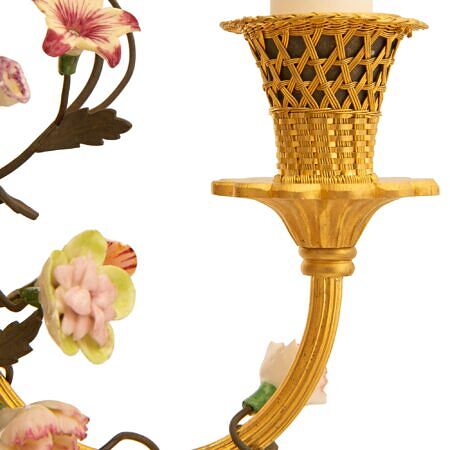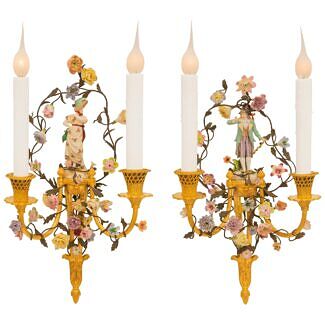A French 19th century Louis XV st. ormolu, tole and Sèvres porcelain sconces
List: $16,900.00
A charming and extremely decorative French 19th century Louis XV st. ormolu, tole and Sèvres porcelain sconces. Each sconce is centered by an elegant bottom acorn finial below beautiful richly chased scrolled acanthus leaves leading up the elegant tapered body.... — Read More
A charming and extremely decorative French 19th century Louis XV st. ormolu, tole and Sèvres porcelain sconces. Each sconce is centered by an elegant bottom acorn finial below beautiful richly chased scrolled acanthus leaves leading up the elegant tapered body. The lightly curved arms each display a fine fluted design wrapped in wonderfully executed vine like branches leading to floral bobeches and unique woven basket candle cups. The beautiful luxuriantly scrolled branches with finely etched leaves display exquisite hand painted flowers with a stunning array of vibrant colors centering charming wonderfully executed personages. The sconce to the left depicts a beautiful maiden wearing a lovely flowing flower dress and a bonnet while the sconce to the right depicts a young man dressed in elegant period attire wearing a bicorne in Napoleon's "en bataille" fashion. All original gilt throughout. — Read Less
Shades shown for display purposes, sold separately.
- Item # 12550
-
H: 18.5 in L: 9.5 in D: 5 in
H: 47 cm L: 24 cm D: 13 cm
- France
- 19th Century
- Ormolu, Porcelain, Tole
- Louis XV st. Read More
- Sèvres Read More
It was founded through the support of King Louis XV of France and at the initiative of Madame Pompadour to be located near her Château.
Due to Sèvres’ reputation for excellence and prestige, it has always attracted some of the best artists throughout history; François Boucher, Albert-Ernest Carrier-Belleuse, Étienne Maurice Falconet, Alexandre Fragonard and August Rodin, just to name a few. Many of these artworks can be seen at the Louvre Museum and the Musée National de Céramique in France.
Initially, Sèvres created a soft paste porcelain know as Biscuit de Sèvres. In 1768 the Bordeaux chemist Villaris and Jean Baptiste Darnet discovered deposits of Kaolin on French soil. In 1771 the Royal Academy sent a report on the creation of hard paste porcelain at which time Sèvres began manufacturing hard paste porcelain.
Louis-Simon Boizot (1743–1809) was a French sculptor renowned for creating Biscuit de Sèvres models, and was the director at Sèvres from 1774-1800, followed by Alexandre Brogniart(1800-1847) and Henri Victor Regnault in 1854.
Related products
-
# 12682 - H: 36" L: 23" D: 10"
-
# 11760 - H: 28" L: 14" D: 9"
-
# 12250 - H: 21" L: 13" D: 9"

























